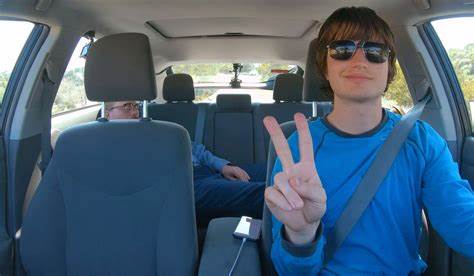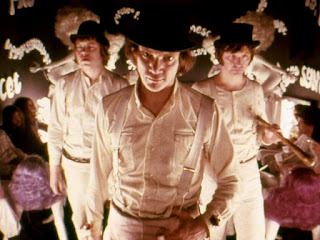'American Psycho' vs 'Spree': Stylish Satire and Subpar Slasher
It’s not a
big secret by this point that my favourite film characters tend to be
psychopaths. These twisted yet nuanced individuals often immediately draw me to
a film. A particular favourite of mine is Patrick Bateman, the murderous
businessman portrayed by Christian Bale in the 2000 satirical horror ‘American
Psycho’ (based off the equally excellent book). So when I saw posters for the
2020 film ‘Spree’ frequently using the statement from Collider “‘American
Psycho’ for the digital age” I was both intrigued and hesitant. Intrigued to
see how the film would direct a similar kind of satire and commentary to modern
society and hesitant as I was almost convinced it wouldn’t succeed. Regardless,
I watched the film and was left disappointed. To be able to express my thoughts
on the film, I will be comparing it to ‘American Psycho’ to highlight where it
missed the mark for me.
‘American
Psycho’ follows Patrick Bateman, a narcissistic 1980’s Wall Street worker, for
a long period of his life as he descends further into a spiral of madness and
violence. ‘Spree’ on the other hand, follows Kurt Kunkle (‘Stranger Things’ star
Joe Keery), an aspiring influencer who, in a quest to achieve internet fame,
spends a night live streaming a killing spree from his taxi. On paper, I found
both these premises interesting, but I found ‘American Psycho’ handled theirs
in a much more compelling way. ‘Spree’ is initially engaging, with interesting
kills and exploration of Kurt’s character and desire for fame. However, the
films struggled to balance these two areas and Kurt begins to feel like little
more than a generic slasher villain. Meanwhile, ‘American Psycho’ is able to juggle
these two areas much more effectively. The film has a similar violence level to
‘Spree’ (and even more in regard to the book), but this tends to take a
backseat to exploring Bateman’s mind. As a result, Patrick Bateman is a much
more layered and intriguing character for me than Kurt is.
As both
films centre almost entirely around one person ‘American Psycho’s’ more
character-focused narrative made it a much more engaging film.
To add to the
narrative comparisons, there is a distinct difference in the way the two films
frame their central character. To demonstrate this, we only need to look at the
first murder in each film. In ‘Spree’, Kurt begins his rampage with the death
of a far-right, white supremacist spokesperson spouting hate speech on his
stream. In sharp contrast, the first death in ‘American Psycho’ is a black
homeless man brutally murdered as Bateman couldn’t relate to him. The
difference couldn’t be clearer. Whilst Kurt was planning to kill his victims
regardless of their personality and does eventually target more innocent
people, the film seems to want to justify the majority of their on-screen
deaths. Whether they were harmful to society, offensive directly to Kurt or
simply irritating, ‘Spree’ seems to need to make their victims as unlikable as
possible before Kurt kills them. As an impact, the film seems to be suggesting
that these characters deserved to die, which seems to position Kurt for most of
the film not as a villain but as a sort of anti-hero. ‘American Psycho’ does
not have this issue. All of Bateman’s victims are presented as innocent, with
their worst “crime” being having a more successful life than Patrick. All
Bateman’s actions are driven purely by his ego, making it much easier to see
him as a villain. In a genre like this, where having a distinct and memorable
villain is so important, I feel that ‘American Psycho’ gets it right which make
it a more terrifying and effective watch.
Another area
where ‘Spree’ failed to match ‘American Psycho’ in my opinion is the way it
delivers its themes and satirical elements. Of course, they are focusing on two
very different groups of people, with ‘American Psycho’ targeting 1980’s
“Yuppies” and ‘Spree’ examining modern day online influencers. Despite this,
the main idea is the same, to dissect and mock successful groups in society.
‘American Psycho’ was never particularly subtle, with Bateman’s monologues
being the main vehicle to explore themes of greed and conformity, but these
were backed up by other smart writing decisions. A running joke in the film and book is that
everyone gets each other’s names mixed up, showing how all these businessmen
seem identical. With this in mind, it becomes clear why Bateman cares so much
and makes monologues about things like business cards, dinner reservations and
pop culture. They reflect his desire to fit into this elite society whilst also
standing out above them. It’s details like this that I feel have made ‘American
Psycho’ into such an iconic piece of satire. ‘Spree’ had the potential to take
the same path, with Kurt making very similar monologues to Bateman. This made
sense as he was talking to a stream but also reflected how he wanted to be seen
as “deep” and inspirational. However, this became less effective as the film
went on. As opposed to smart, intricate details, ‘Spree’ opts to have multiple
characters give monologues about internet culture or be caricatures of internet
groups. This was made worse by the comments on the stream, which while occasionally
interesting, seemed to mostly state the obvious. This resulted in a messy,
ham-handed attempt to break down modern internet culture that didn’t bring
anything new to the discussion. In a way the film comes across a lot like Kurt
himself, trying to be insightful and provocative but ending up shallow.
Whilst these
comparisons did lessen my overall opinion of ‘Spree’, there is one area it
really excels, this being its camerawork. Most shots from the film are shown
from the perspective of cameras on a livestream, whether this is Kurt’s phone
and cameras in his car or another character’s phone. In situations where these
can not be used, security camera footage is used instead. The film also shows shots
on a phone screen displaying Google searches or YouTube videos. Occasionally, several
cameras will be on screen at once to show events from multiple perspectives.
This makes the film feel dynamic and fast-paced in a way that conventional camerawork
like that in ‘American Psycho’ sometimes can’t. This effective use of modern
internet technology along with the comments, which while often annoying made
the experience feel immersive, showed me that the filmmakers had a real-life
understanding of the way the internet is actually used. In the end, these
visual quirks didn’t significantly change my perception on ‘Spree’, but it did
make it a bit more enjoyable to sit through. In the future I’d like to see this
style of filming explored again as a modern successor to the found footage
genre.
In
conclusion, it’s clear to me that ‘Spree’ has a desire to replicate and
modernise the dark yet insightful style of ‘American Psycho’ but fails to live
up to these expectations. With a less compelling narrative and messy
exploration of its themes, it seems like little more than a pale imitation of an
iconic film and piece of literature. As a whole, I feel ‘Spree’ was mis-marketed,
or at least towards me it was. When taken as a somewhat cheesy horror comedy,
the film arguably succeeds. With all that said, for anyone who watched ‘Spree’
or likes the sound of the premise, I would wholeheartedly recommend the 2014
film ‘Nightcrawler’, staring Jake Gyllenhaal as Lou Bloom, a psychotic news
cameraman. This film touches on many similar ideas and themes as ‘Spree’ such
as the demand for media in a much more intellectual and haunting manner, which
made it a personal favourite film.





Comments
Post a Comment